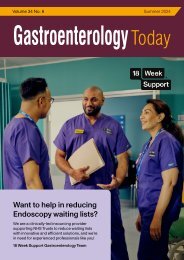Gastroenterology Today Autumn 2020
Create successful ePaper yourself
Turn your PDF publications into a flip-book with our unique Google optimized e-Paper software.
FEATURE<br />
TRANSPLANTATION DURING THE<br />
COVID-19 PANDEMIC: NOTHING NOBLE<br />
IS ACCOMPLISHED WITHOUT DANGER<br />
Gabriele Spoletini 1* , Giuseppe Bianco 1 , Dario Graceffa 2 and Quirino Lai 3<br />
Spoletini et al. BMC <strong>Gastroenterology</strong> (<strong>2020</strong>) 20:259 https://doi.org/10.1186/s12876-020-01401-0 © The Author(s). <strong>2020</strong><br />
GASTROENTEROLOGY TODAY - AUTUMN <strong>2020</strong><br />
6<br />
Abstract<br />
The global health crisis due to the fast spread of coronavirus disease<br />
(COVID-19) has caused major disruption in all aspects of healthcare.<br />
Transplantation is one of the most affected sectors, as it relies on a<br />
variety of services that have been drastically occupied to treat patients<br />
affected by COVID-19. With this report from two transplant centers<br />
in Italy, we aim to reflect on resource organization, organ allocation,<br />
virus testing and transplant service provision during the course of<br />
the pandemic and to provide actionable information highlighting<br />
advantages and drawbacks. To what extent can we preserve the noble<br />
purpose of transplantation in times of increased danger? Strategies to<br />
minimize risk exposure to the transplant population and health- workers<br />
include systematic virus screening, protection devices, social distancing<br />
and reduction of patients visits to the transplant center. While resources<br />
for the transplant activity are inevitably reduced, new dilemmas arise to<br />
the transplant community: further optimization of time constraints during<br />
organ retrievals and implantation, less organs and blood products<br />
donated, limited space in the intensive care unit and the duty to<br />
maintain safety and outcomes.<br />
Keywords:<br />
Coronavirus, Transplantation, Organ donation, SARS-CoV-2, COVID-19,<br />
Virus tests.<br />
Background<br />
Since December 2019, the fast spread of the novel Severe Acute<br />
Respiratory Syndrome CoronaVirus-2 (SARS-CoV-2) causing a severe<br />
acute respiratory disease (COVID-19), has determined a healthcare<br />
crisis in a growing number of countries. To date, USA, Spain and Italy<br />
have reported the highest number of patients affected, and COVID-19<br />
has been categorized as a global pandemic [1]. Disruptions in<br />
almost all aspects of health care provision have been observed, and<br />
health systems are trying to continue offering essential services while<br />
suspending those that can be postponed.<br />
Transplant services can be categorized depending on their lifesaving<br />
nature. Heart, lung and liver transplants are urgent lifesaving operations<br />
in a proportion of wait-listed patients. In particular, those with chronic<br />
end-stage organ disease who develop deterioration of their baseline<br />
condition, and those who suffer from sudden end-stage failure of a<br />
given organ.<br />
*<br />
Correspondence: gabriele.spoletini@policlinicogemelli.it<br />
1<br />
General Surgery and Liver Transplantation, Fondazione Policlinico<br />
Universitario A. Gemelli IRCCS, Largo Agostino Gemelli 8, 00168 Rome, Italy<br />
While it seems obvious that lifesaving transplant activity should not<br />
be stopped, it is not clear whether nonlifesaving transplants should<br />
be delayed past the most critical phase of the emergency. In fact,<br />
prolonging the time spent on the waiting list can translate into waiting list<br />
drop-out due to disease progression or overcoming contra-indications.<br />
On May 3, <strong>2020</strong>, Italy is the third most affected country worldwide<br />
and has registered the second highest number of COVID-19-related<br />
deaths so far. The Italian National Authority for Transplantation released<br />
guidance on donor and recipient testing for SARS-CoV-2 [2, 3]. Testing<br />
via naso-pharyngeal swab (NPS) or bronchoalveolar lavage and, if<br />
positive, measurement of viral load on blood sample are recommended<br />
in all donors from high incidence regions. SARS-CoV-2 positive potential<br />
deceased donors are to be discarded and living donors postponed.<br />
NPS is compulsory before transplantation for all potential recipients who<br />
are symptomatic or with a history of contact with a COVID-19 positive<br />
patient, and discretional for asymptomatic recipients in whom history of<br />
contact with COVID-19 positive patient can be reasonably ruled out.<br />
Implications of the spread of COVID-19 for the transplant community<br />
are innumerable, and the unprecedented nature of the pandemic has<br />
left physicians without guidance in many of their management choices.<br />
Balancing resource constraints, patient safety and life-saving organs<br />
demand is difficult during COVID-19 pandemic. With the present report<br />
we aim to reflect on the open challenges for the transplant community.<br />
A summary of actions to be undertaken is summarized, reflecting on<br />
advantages and dangers related to each (Table 1).<br />
Screening and risk exposure for transplant staff<br />
Since the beginning of the pandemic, health-workers screening<br />
has been advocated as an essential tool for: 1) protecting patients<br />
from staff-mediated transmission and 2) protecting health-workers<br />
allowing prompt treatment. In the setting of transplantation, the first is<br />
of paramount importance, being the immunosuppressed population<br />
more vulnerable to infections. As of February 11, <strong>2020</strong>, out of 44,672<br />
confirmed COVID-19 cases in Mainland China, 1716 (3.8%) cases were<br />
health-workers [4]. To date, 21,338 health-workers have tested positive<br />
for SARS-CoV-2 in Italy and 154 doctors (including retired ones) and<br />
40 nurses lost their lives after being infected [5]. Shortage of personal<br />
protection devices and work overload have contributed to increase<br />
the rate of contagion within health-workers. Hosts of SARS-CoV-2 may<br />
transmit the virus while they are asymptomatic or during the incubation<br />
period, a mechanism that creates a vicious circle of in-hospital disease<br />
spread to patients and staff. Testing all the transplant staff (or, at least,<br />
those who come into contact with transplanted patients) could mitigate

















